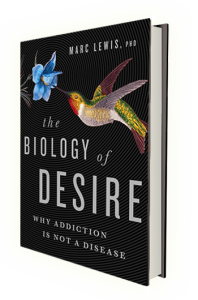In response to my last post, some of you expressed interest in mindfulness/meditation as a means for overcoming addiction. Today I want to relate the calm centre of IFS with the calm place we find in meditation. They are similar in some ways and very different in others.
There will be more posts on mindfulness, and I promised to visit “Mindfulness-based Relapse Prevention”, a fusion of mindfulness with CBT expressly developed for addiction. But today’s post will be about my personal experiences and thoughts.
Last night I sent the finally-fully-edited draft of my first novel to my agent. I’ve been working on this manuscript for roughly four years, so you can imagine, today I feel this sort of yawning emptiness. Like, now what am I supposed to do? The day seems to lack structure and meaning. I have moments of delicious relief, but at other times I feel confused and lost.
So I did my morning meditation (nothing heroic — just 12 minutes with the Sam Harris Awakening app) and it happened to be an episode focused on emotions. True to Buddhist tradition, Sam H urged us to let emotions come…and go. Anger, anxiety, whatever it is, let yourself feel it, don’t fight it, don’t hold onto it, just recognize it as colouring the field of consciousness. And that’s all, he reminds us. You don’t have to do anything, because consciousness is its own goal. Just be there and be aware.
I figure this is the centrepiece of (Vipassana?) mindfulness meditation. Good stuff, to be sure. Especially when craving is a real problem. Recognizing that craving is simply a feeling, without a particular requirement or needed resolution, can be most beneficial.
But nowadays when I meditate I often go into IFS land. (See my last eight posts if you’re not familiar with IFS, or go online). It’s different. The emotions I felt this morning, while meditating, were mostly a mix of anxiety and resentment, tinged with a wish to rebel or even get high. So…what the fuck’s that about? Simple, according to mindfulness meditation: let the feelings be there without being carried away. Simply let yourself be aware of them. What does IFS say?
In IFS, as I’ve tried to explain, there’s a place they call Self (with a capital-S) which is different from the “parts”. It is a place of being centred, calm, patient, compassionate, accepting, noticing, even welcoming whatever comes. As you can imagine, whatever comes usually involves the “parts” that have needs, concerns, and fears. Now this central place of calm acceptance seems very similar to the calm place you get to in meditation. But here’s the difference. You don’t just sit there in the centre of it, you meet and greet, as it were, the parts that need something. You connect with them, welcome them, follow them to their origins…you can sit with them, and you can soothe them. One form of soothing is to invite the parts to come and be with You (captital Y?) in the present, away from the bleak place where they remain fixated. A mysterious and perhaps mystical process that can work wonders.
So today I went and followed the dissatisfied angry part to get to know it better.
I had an experience of sexual assault in my teenage years. I have never disclosed this publicly, but after listening to Tim Ferriss (a very popular podcaster) disclose his history of sexual abuse, I thought, what am I trying to hide? Many of us who’ve been addicted have experienced something similar. In fact the link between trauma and addiction is well known. I want to understand this link in my own life. To look the other way is unhelpful — both personally and as part of a community.
I’ll leave it at that, without details, for now. The aftermath is what preoccupies me.
 My first year in Berkeley, California. It’s 1968-69. The sun is shining, exotic flowers and trees line the streets, the hippie types (including me, sort of) wear their colourful clothes with playful exuberance. There were smiles on many faces. Fascinating men, beautiful women. We felt like we were ushering in a new age of humanity, a real cultural revolution.
My first year in Berkeley, California. It’s 1968-69. The sun is shining, exotic flowers and trees line the streets, the hippie types (including me, sort of) wear their colourful clothes with playful exuberance. There were smiles on many faces. Fascinating men, beautiful women. We felt like we were ushering in a new age of humanity, a real cultural revolution.
 But I was lost. I wandered the streets feeling empty and unreal. I didn’t know what to do with myself. Depression crashed down on me every evening I was alone — that is, without my roommate or my part-time girlfriend, Susan. I had a very hard time being with family members, because I felt there was something deeply wrong with me, beneath contempt. I resented the walls of politeness that seemed to shut me out of their lives. I lived in a pool of shame that was almost impossible to sense clearly because it was so constant. I have no doubt that my traumatic experience created or refined this part of me — broken, shamed, empty.
But I was lost. I wandered the streets feeling empty and unreal. I didn’t know what to do with myself. Depression crashed down on me every evening I was alone — that is, without my roommate or my part-time girlfriend, Susan. I had a very hard time being with family members, because I felt there was something deeply wrong with me, beneath contempt. I resented the walls of politeness that seemed to shut me out of their lives. I lived in a pool of shame that was almost impossible to sense clearly because it was so constant. I have no doubt that my traumatic experience created or refined this part of me — broken, shamed, empty.
 But there was one way to feel better, to feel…vital. Drugs. You can bet there were a lot of drugs available in Berkeley in those days. And they worked. From cannabis I went to psychedelics, acid two or three times a week, riding my motorcycle through thickets
But there was one way to feel better, to feel…vital. Drugs. You can bet there were a lot of drugs available in Berkeley in those days. And they worked. From cannabis I went to psychedelics, acid two or three times a week, riding my motorcycle through thickets  of hallucinations, and then from psychedelics to heroin, and then on to pharmaceuticals and crime. Check out my first book on addiction — Memoirs of an Addicted Brain — for the gory details. Two parts of me: one sinking into this sickening, passive emptiness, this incoherent shame, the other energized to find new and more powerful drugs and drug-tinged adventures, to fill up that empty space with magical potency. And through drug use, defy everyone who’d tried to tell me how to behave.
of hallucinations, and then from psychedelics to heroin, and then on to pharmaceuticals and crime. Check out my first book on addiction — Memoirs of an Addicted Brain — for the gory details. Two parts of me: one sinking into this sickening, passive emptiness, this incoherent shame, the other energized to find new and more powerful drugs and drug-tinged adventures, to fill up that empty space with magical potency. And through drug use, defy everyone who’d tried to tell me how to behave.
The wounded part never went away. Nor did the defiant part. That’s a fundamental insight of IFS: the parts can evolve, but they don’t disappear. As for the wounded part, its sense of being lost and helpless still hobbles me with a certain anxiety, vulnerability, and hesitation — but not nearly as much as it did. And I have other strong, brave parts with impressive energy. Often they lead — sometimes brilliantly.  Now, when my meditation leads me to my wounded parts, I greet that 17-year old kid and let him know that it’s not his fault, that I accept him completely — him and his 12-year spree of crime and self-abuse — and that I love him. I let him know that he doesn’t have to live in that crazy, tilted world anymore. And that’s all he needs, that acceptance and care. It heals him.
Now, when my meditation leads me to my wounded parts, I greet that 17-year old kid and let him know that it’s not his fault, that I accept him completely — him and his 12-year spree of crime and self-abuse — and that I love him. I let him know that he doesn’t have to live in that crazy, tilted world anymore. And that’s all he needs, that acceptance and care. It heals him.
……………..
I should mention that Ferriss also interviews Richard Schwartz, the founder of IFS in a recent episode. This is a cool podcast: Schwartz explains IFS succinctly, compares it to aspects of psychedelic (MDMA) psychotherapy (fascinating!), and then does a live IFS session with Ferriss as the client.
 Informed by unparalleled neuroscientific insight and written with his usual flare, Marc Lewis’s The Biology of Desire effectively refutes the medical view of addiction as a brain disease. A bracing and informative corrective to the muddle that now characterizes public and professional discourse on this topic.” —Gabor Maté, M.D., author of In The Realm of Hungry Ghosts: Close Encounters With Addiction
Informed by unparalleled neuroscientific insight and written with his usual flare, Marc Lewis’s The Biology of Desire effectively refutes the medical view of addiction as a brain disease. A bracing and informative corrective to the muddle that now characterizes public and professional discourse on this topic.” —Gabor Maté, M.D., author of In The Realm of Hungry Ghosts: Close Encounters With Addiction
Hey Marc
I absolutely love this blog. Not only is it a great illustration of how IFS works, it also demonstrates how the warring/competing factions can tear us apart and often feel irreconcilable. As you have, so eloquently, said its reconciliation of these parts that can lead us to healing, resiliency and unconditional love. Personally I think that deep within us all is a very lost little child who is scared, hurt, unloved, lonely and shameful. He needs to feel things like acceptance, trust, loving kindness and warmth maybe, initially, from someone else as he learns to harmonise the competing factors and give it to himself. That’s why, in my humble opinion, a good therapeutic relationship is so important. Anything else could be very damaging.
Thanks again my friend
Thank you, Peter. What you say about the scared, lost child within us and the importance of a good (!) therapeutic relationship cannot be overemphasized. (I’m not sure if that shamed child is universal as you say — but maybe, since pretty much all parents resort to shaming at least sometimes. Anyway, those of us who’ve been addicted…yep, for us it’s pretty fundamental.)
Have I mentioned that I’ve become a client in IFS therapy, with a marvelous therapist? I am learning so much. About myself and about being a good (!) therapist.
One thing I recently learned is the difference between pity and compassion. I thought they were nearly the same thing. Not at all. Pity is condescending. We often wrap wounded parts in pity, because it does offer to protect them from more hostility, accusation, etc. But it does not relieve shame, because the “victim” remains the victim. Oh you poor thing. One fascinating thing about pity is that it is learned from others, who feel sorry for our pain — from a remove. As in “I’d hate to be you.” Or “Too bad for him.” Another thing: the protector part who continues to pity the wounded part (as in self-pitying) feels committed to that role, because, well, it is protective in its own way. And the wounded part may feel wrapped up and safe — but it’s safe within a shell. You can’t really free yourself from it. In fact you may cling to it.
Whereas compassion (a word that crops up a lot these days in mindfulness circles, e.g., Tara Brach) is in no way condescending. It’s patient, still, curious, aware, and completely non-judgmental. It asks “what was it like?” rather than asserting “oh you poor thing.” The term “self-compassion” is perhaps overused. People see it as identical to feeling sorry for yourself. IFS practitioners who know their stuff recognize this as somewhat misguided, as coming from another burdened protector, who’s doing its best yet keeps the system locked up in a self-defeating cycle of pain, shame, and self-blame.
Thank you so much for this post, it was so useful for me. I think that it’s possible that on some occasions when I am meditating, a part may emerge that wants attention, but because I am noticing what comes up rather than engaging with it, that part feels ignored, or rejected. One of my female parent’s unlovely behaviours towards me was to completely ignore me for periods of time, so in not engaging with the part, it feels I’m behaving like she did, it feels abused. For now I’m going to park insight meditation and use the IFS meditations I downloaded, led by Richard Schwartz. Perhaps I’ll return to meditation when I feel skilful enough to know when to engage with a part. Also, this helps me understand why I haven’t established a regular meditation practice, despite 30 odd years of giving it a go, more off than on. Thanks again!
Hi Jackie. Very astute observation of what’s going on inside. What you are discerning sounds accurate and deep.
I wouldn’t say you have to abandon the Buddhist style of “just observing” or whatever….but it’s true that the parts — often experienced as splashes of negative emotion — often seem to arise out of some intention or wish to be met and attended to. I still find it mysterious, but it gets easier and easier to move from one style of mindfulness to the other, so to speak. The other thing I find mysterious is that the capital-S Self of IFS seems pretty much identical to the still, open, peaceful place you sometimes get to in Buddhist meditation. Yet the Buddhists call that “non-self”.
I guess words are just these pretty coarse estimates when it comes to exploring our inner worlds.
Thanks for this window into…how things often seem to work.
The instant the problematic emotion becomes the object of attention, it kills off it’s pure expression. It knows it’s being watched. It’s been objectified for potential intellectualization…I think.
Hi Kathryn. I get what you mean. But there are different kinds of attention. It’s true that our intellectual resolution-focused style of attention can chase off the essence of the emotional reality. Some would say that’s one of its primary purposes. Like think about Enlightenment-era ideas: passion bad, reason good. But there’s another style of attention that seems almost synonymous with the word “perception” — just seeing, experiencing, and in this case feeling whatever arises. Sometimes to me it feels like a “falling back” rather than “leaning into”…regarding the thing being attended to. It probably improves with practice. I think it’s notable that the IFS gurus emphasize curiosity as a characteristic of this “Self-led” attention.
Thanks for this contribution!
Great to see you here, Marc and community. I saw a great post on The Friendship Bench Project which is from Zimbabwe, Africa.
https://www.friendshipbenchzimbabwe.org/
I love the work they do and the very very practical applications. For sure, a bench!!
Recently they posted about identifying emotions. What is it that you are feeling??
I know from years of being in crisis over my loved ones addictions I had lost touch with how and what I was feeling… let alone what others were feeling… and how to find some peace. Meditation works. Lighting a candle works. And I’m working on my Friendship Bench.
Very cool, Janet. I went to the site and it’s really quite inspiring. What comes to my mind is the Open Dialogue approach to mental health care, which came out of Finland but seems to be catching on all over the place. Interesting that these two community-based help modalities originated at nearly opposite ends of the world!
I also just discovered that there’s a Friendship Bench organization here in Canada and seemingly in other countries far from Zimbabwe. I wonder how widespread this idea is…and whether and how it’s connected across these highly diverse countries and cultures. I’m just learning about this for the first time. But I encourage readers to check out this link if interested. There’s lots of info and it’s damn inspiring.
There is a sentence from R.D. Laing which has always intrigued me:
“The self which condemns itself is the last to realize that it is not only the self it condemns that stands in need of forgiveness, but the self that condemns.”
Any thoughts?
Fabulous: pretty much a Zen Koan for the IFS idea that the “manager” parts can be experienced as coming at us, but they are also in need of understanding and forgiveness themselves. It seems particularly difficult to have a friendly (internal) dialogue with a part that is contemptuous of our inner weakness or turmoil. But it’s far from impossible, especially when you recognize that these parts arose out of desperation to keep the train on the tracks.
My father used to beat me. Perhaps, he was more trapped in his pain than I am – I can’t free myself without feeling his pain.
Perhaps, it is not only a matter of engaging in a friendly (internal) dialogue with the self that is is contemptuous of our inner weakness, but also and perhaps foremost, being able to feel its pain.
Forgive yourself first.
Marc That description of the defiant and wounded part so helpful. You put addiction in to useful words. I havent been up to reading blogs much as my current job since covid has me stuck to technology all day long phone and computer. So I’m burnt out on screens at the end of the day. But I miss your blog!
Also I identify with what you say about sex abuse. I too for years and years hid and stuffed a couple terrible experiences thinking I was to blame. It was so freeing when I shed that burden. Although I still hesitate to tell people, as I think I might not be believed. Of course that’s the reason I stuffed it in the first place. And it was at the root of my addictions. Now I truly believe in my self and know I was not to blame and that’s so so healing. But anyway, your so right, what’s to hide?
Lovely. Thanks for the endorsement and the sharing. I won’t say more about my experience right now, but I hear this over and over and over: it’s not only abuse (which, yes, is certainly a gateway to addiction), but it’s sexual abuse that is particularly insidious as a causal link. I guess it’s all about shame. What else could it be?
We’re all a bit burned out on our screens these days. But it sure is nice to hear from you people. We seem to have a lot in common, and sharing the dark parts creates a unique kind of light.
Yes… I believe it does create a light… a comforting light.
Hi Marc,
Love your work, blog and have learnt alot and was wondering what your thoughts are on this side of drug use and argument, which I never had heard of…
https://www.theguardian.com/society/2021/feb/06/meet-carl-hart-parent-columbia-professor-and-heroin-user
Hi Marc
Another great post and so the issues a lot of them you have covered already I’d just like to add how we bring into view I’d really like to hear more about are.
Managing set backs
Nurturing self compassion
Creating connection (perhaps as something other than NA/AA/SMART etc
Creating purpose meaning and opportunity
Managing intense emotions
Repetitive negative self narrative
The Givens
I work with addiction and I am in constant recycling of my own also I do try not to bring preconception, however it feels inevitable i’m really struggling to bring authentic openness to my work I also wonder if concepts such as ‘addiction’ ‘recovery’ even have validity given that they are borrowed from politicised agendas, and have such enduring and powerful connotations defined for us.
Thank you Marc. I’ve been wondering how to integrate Vipassana meditation and IFS together for they seem to differ in approach. But I see my vipassana practice as a great compliment to my ifs sessions. My confusion is over whether every sensation I feel in vipassana is a ‘part’? And whether I should interact with my parts during a vipassana meditation? If you have any thoughts on this I’d greatly appreciate them. Blessings to you 🙂
This is a great question, Will. I think about it a lot. Very briefly, I often start with a “regular” Vipassana style meditation, focus on the breath, etc, and then fade into IFS. The parts call to me, they’re right there — no digging required — and the compassion from Self to parts takes over. The conduit is almost seamless.
No, I don’t think every sensation is a part. Not at all. I mostly find the exiles to be the clearest. Powerful emotional wellsprings. Especially shame and fear. The sensations seem to belong to the parts. After all, they have sensations too –why shouldn’t they? And the sensations often lead me to the center of the part. Like a cringing feeling in my stomach…and there’s that 5-year old, right there. I can “be” him but I can also talk with him and comfort him.
I just ordered this book: Daily Parts Meditation Practice.. Just yesterday! Chatting with Gabor Mate and he recommended it. His latest “compassionate inquiry” model seems to have a lot in common with IFS, though I haven’t explored this yet.
Happy to talk about this more if you wish.
All the best!
This is so interesting thank you Marc! Not every sensation is a part is so helpful. I’d love to hash this out more as I got confused when I heard Dick on a podcast talk about how IFS sort of opposes the indifference to feelings that mindfulness cultivates. I’m so intrigued by a synthesis of the two as I also know advancing in meditation really helps to connect with my parts in a session. I’ll check out the book thank you. What’s the best way to chat further? 🙂
Could you please explain the steps in your meditation with Self? I am somewhat familiar with IFS. Do you sit as Self? Then as the parts arise, you interact with them? What is the process?
Hi Karl. It’s not an explicit procedure, really, just a sequence that seems to unfold time and time again. I go into my breath, start to feel peaceful in my body, etc, as you would in standard Buddhist meditation. Then I just start to notice the parts…they are sort of implicit in the emotions that glide (or geyser) to the surface. So I might notice anger or anxiety. Then I just notice that there’s a young part, a young manager or an exile perhaps, bumping up into my consciousness. That’s who’s angry or scared. And that’s when I kind of sink into Self…totally in relation to that part. My Self becomes more present as my attention to the part becomes more focal. What I feel tends to shift into compassion, and it’s that Self-part interaction that allows that to happen.
In standard Buddhist meditation, they seem to save “compassion” for Meta, a sense of empathy for others. But the kind of meditation that emerges for me in the IFS modality has compassion at the core.
I can’t describe it much better for now. It just unfolds…and I follow it. Please try it yourself and let us know your experience.